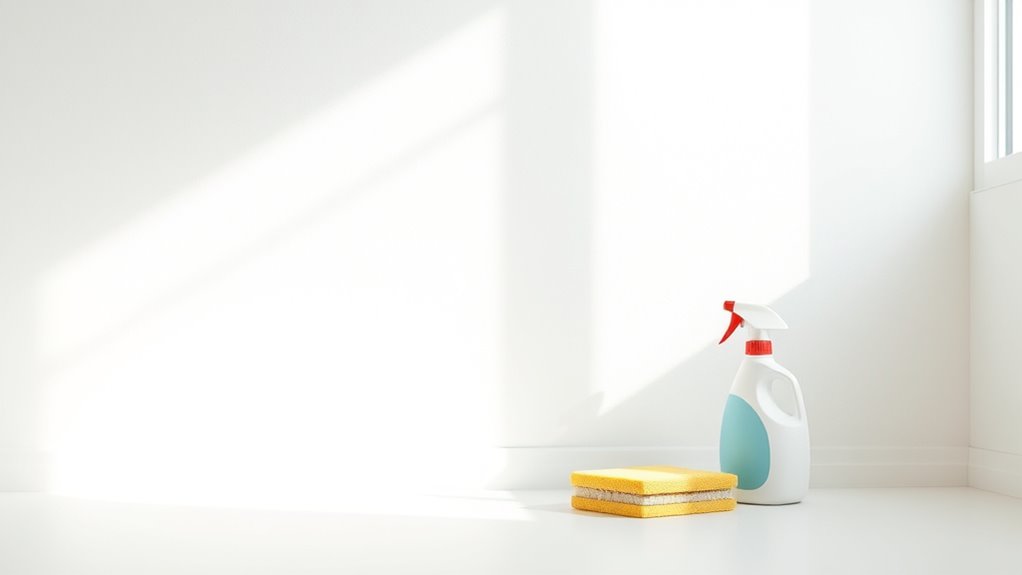To eliminate smoke stains and odors from walls, start by evaluating the damage and wearing protective gear. Use a mix of white vinegar and water or mild dish soap for initial cleaning. Scrub gently in circular motions and guarantee good ventilation. For stubborn stains, consider ammonia solutions or trisodium phosphate cautiously. After cleaning, apply a stain-blocking primer before repainting with high-quality paint. Want to know more techniques and tips for effective restoration?
Key Takeaways
- Assess the extent of smoke damage and wear protective gear before starting the cleaning process.
- Use a mixture of white vinegar and water to effectively break down smoke stains and neutralize odors.
- For tough stains, apply ammonia in a well-ventilated area while wearing gloves and goggles.
- After cleaning, apply a stain-blocking primer to seal any lingering stains before repainting.
- Ensure good ventilation throughout the process and consider multiple cleaning cycles for deep-set stains.
Preparation and Inspection
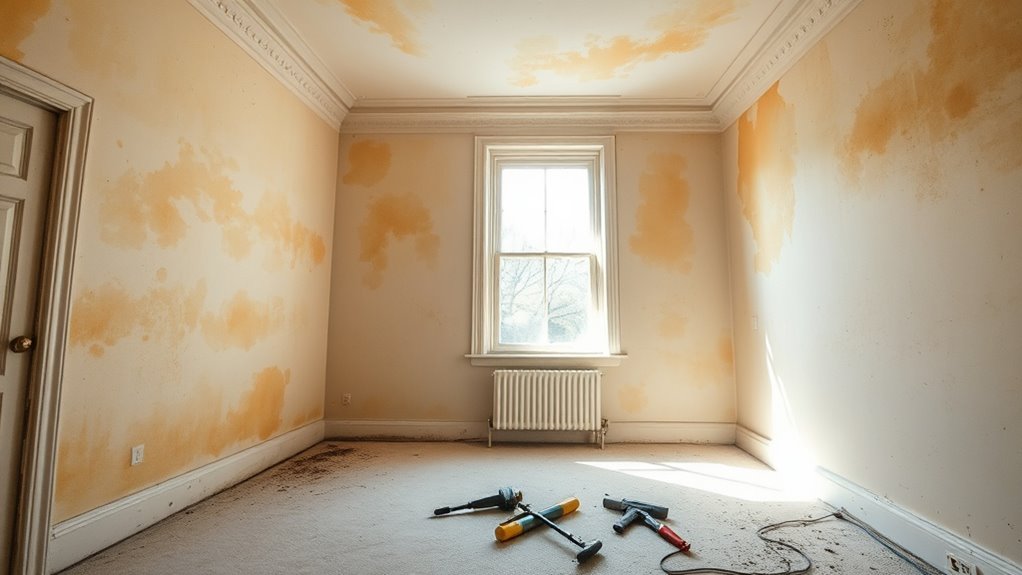
Before diving into the cleaning process, preparation and inspection are essential steps in tackling smoke stains and odors on your walls.
First, assess the damage to understand the extent of the smoke stains and odors. Wear protective gear like gloves and masks to avoid soot exposure, and guarantee good ventilation by opening windows and using fans. It is important to remember that smoke stains can vary in composition based on their source, which influences the cleaning methods you should use.
Clear away loose debris to make cleaning easier. Inspect for visible stains and hidden odors, and consider the wall materials, as this will influence your cleaning approach.
If your home is older, check for asbestos in materials like popcorn ceilings. Taking these precautions helps you effectively tackle smoke damage while prioritizing your safety and minimizing further harm.
Effective Cleaning Solutions
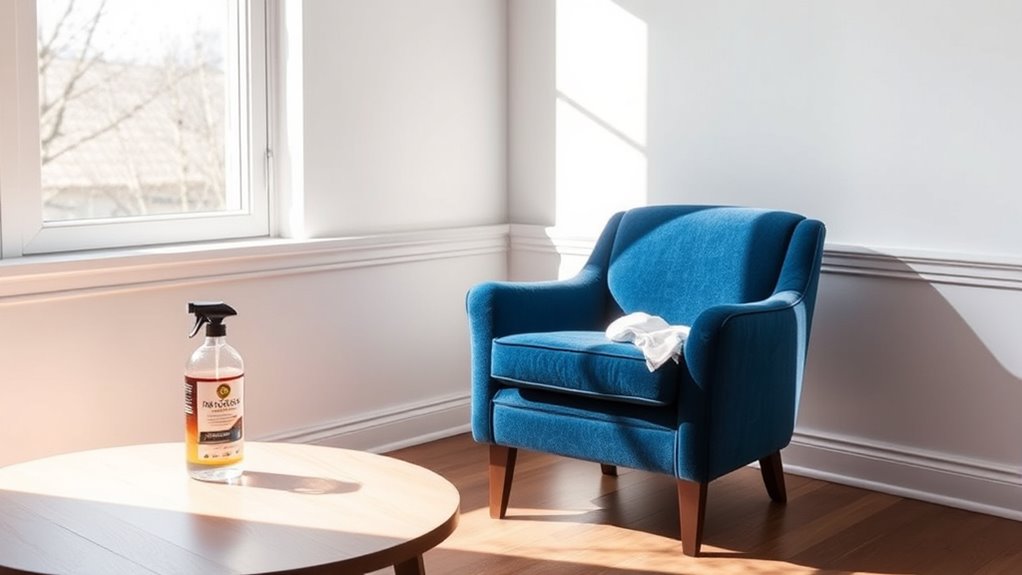
To tackle smoke stains and odors effectively, you’ll want to choose the right cleaning solutions that suit your needs.
White vinegar serves as a natural degreaser, while ammonia works wonders on tough stains—just remember to use gloves and guarantee good ventilation. For a gentler approach, mix dish soap and baking soda in hot water; it’s effective yet mild. Trisodium phosphate (TSP) is excellent for heavy stains but requires caution due to its harshness. For small or lightly soiled areas, a Mr. Clean Magic Eraser can be your best friend. Always prioritize safety by using protective gear where necessary and ventilating your space to minimize inhalation risks from chemical fumes. Cleaning is essential to avoid ongoing health risks from residual nicotine and chemicals in smoke.
Choose wisely, and you’ll see great results.
Application Techniques for Cleaning
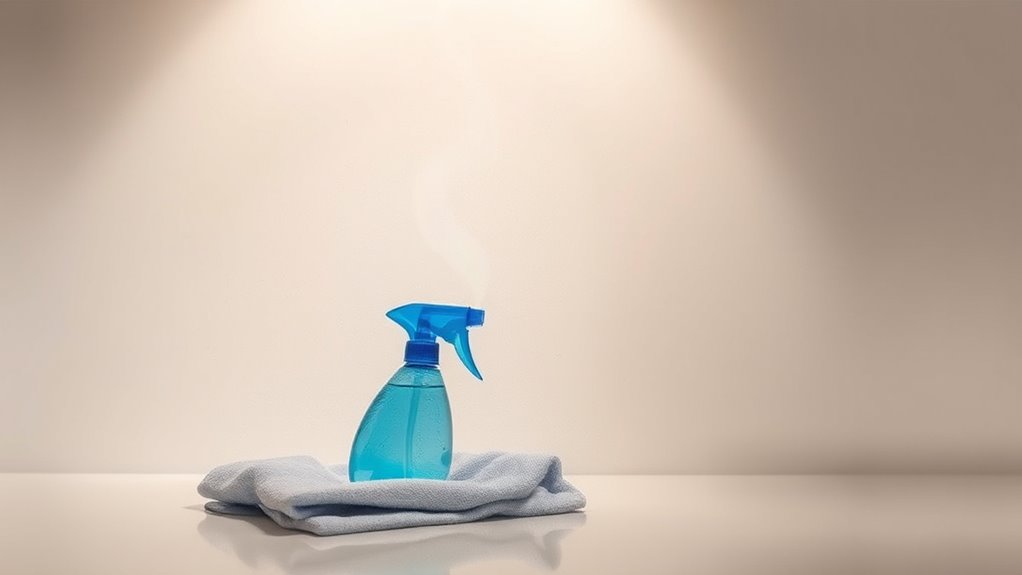
Effective application techniques are essential for successfully eliminating smoke stains and odors from your walls. Start by protecting surrounding areas with drop cloths or plastic sheets to avoid damage. Guarantee good ventilation by opening windows and using fans, and don’t forget to wear rubber gloves and safety goggles for protection. Conduct patch tests on inconspicuous areas to check for any adverse reactions. Use a sponge or cloth to scrub stains in a circular motion, applying gentle pressure to prevent wall damage. A higher contrast ratio can enhance image quality and improve the visual experience when cleaning. After scrubbing, thoroughly dry the cleaned areas with a clean cloth and rinse with fresh water to remove any residue. These steps will help you achieve peak results and maintain your walls’ integrity, while also ensuring that professional services can complete the job effectively if needed.
Tackling Stubborn Stains and Odors
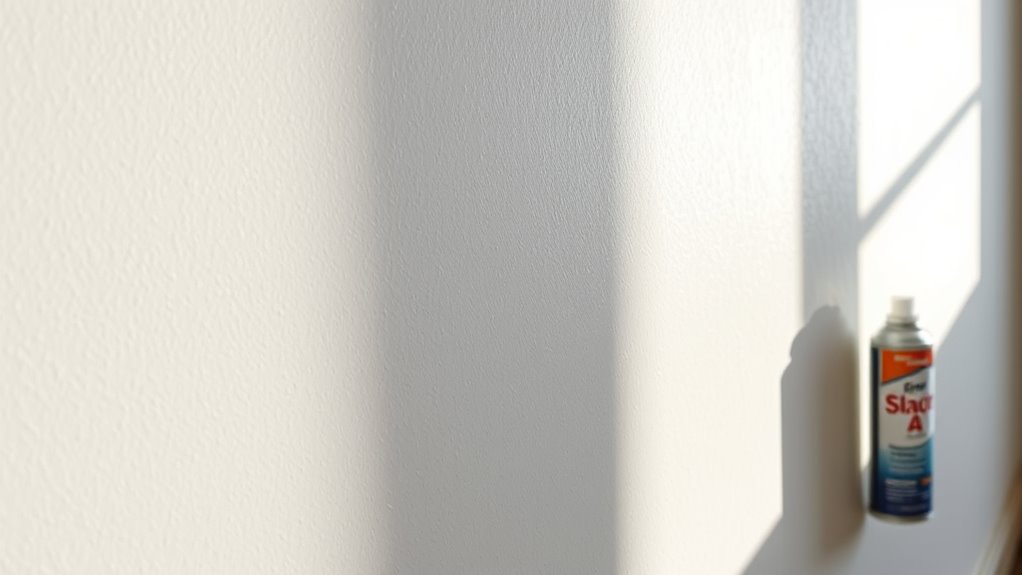
While tackling stubborn stains and odors, you’ll need to employ specific strategies to achieve the best results. Start with a mild dish soap and warm water for initial cleaning. If that doesn’t work, mix white vinegar with water to break down smoke stains and neutralize odors. For nicotine stains, try an ammonia solution, but remember to wear protective gear and guarantee proper ventilation. Vacuuming is also an important first step, as it helps remove loose debris before applying cleaning solutions. Baking soda works wonders too; make a paste with water or sprinkle it on surfaces to absorb lingering odors. Sometimes, you may need multiple cleaning cycles for deep-set stains. Don’t hesitate to seek professional help if the issues persist, as they can guarantee thorough cleaning and restore your walls effectively.
Repainting and Stain Blocking Methods

Repainting your walls after cleaning is essential for restoring their appearance and eliminating any remaining smoke odors. Start with a stain-blocking primer to effectively seal in any lingering stains. Options like Zinsser’s Cover Stain or KILZ Restoration Primer work well, but remember to wear a high-quality respirator when using products with strong fumes. Applying a solvent-based stain-blocking primer will ensure that any stains do not bleed through the new paint. Allow the primer to dry completely, usually 24 hours, before moving on to paint. Choose a high-quality interior latex paint with stain-resistant properties and apply at least two coats for full coverage. Airless paint sprayers can significantly reduce the time needed for this process while providing a smooth finish. Make sure each coat dries before adding another. For a smooth finish, sand surfaces and patch any imperfections before painting. This process will leave your walls looking fresh and clean.
Professional Restoration Options

After tackling the initial cleaning and repainting of your walls, you might find that some smoke damage requires professional intervention.
Professional restoration services offer expertise and experience, ensuring your property is thoroughly assessed for smoke damage. Technicians use specialized equipment like hydroxyl or ozone generators to remove stubborn odors, while adhering to safety protocols during the process.
They implement containment techniques to isolate affected areas and prevent odors from spreading. Advanced cleaning methods, such as dry and wet cleaning, help restore materials effectively.
With certification and continuous training, these professionals guarantee extensive service, including structural and cosmetic repairs, so you can breathe easy knowing your home is completely restored.
Preventive Measures for Future Issues

To prevent future smoke damage and odors from infiltrating your home, it’s essential to implement effective strategies before issues arise.
Start by choosing fire-resistant carpets and non-absorbent upholstered furniture to minimize smoke accumulation. Use specialized, stain-blocking paints and apply protective coatings to walls for added defense. Additionally, ensure that you gather necessary supplies before starting any painting or priming project to maintain a clean and organized workspace.
Guarantee good air management by maintaining your HVAC system and using air purifiers to capture smoke particles. Enhance ventilation through cross-ventilation and fans to dissipate any smoke that might enter.
If smoking indoors is unavoidable, consider design choices like smaller, dedicated smoking areas and air-tight doors to limit smoke spread.
Taking these preventive measures can notably reduce the risk of smoke stains and odors in your living space.
Maintaining a Smoke-Free Environment
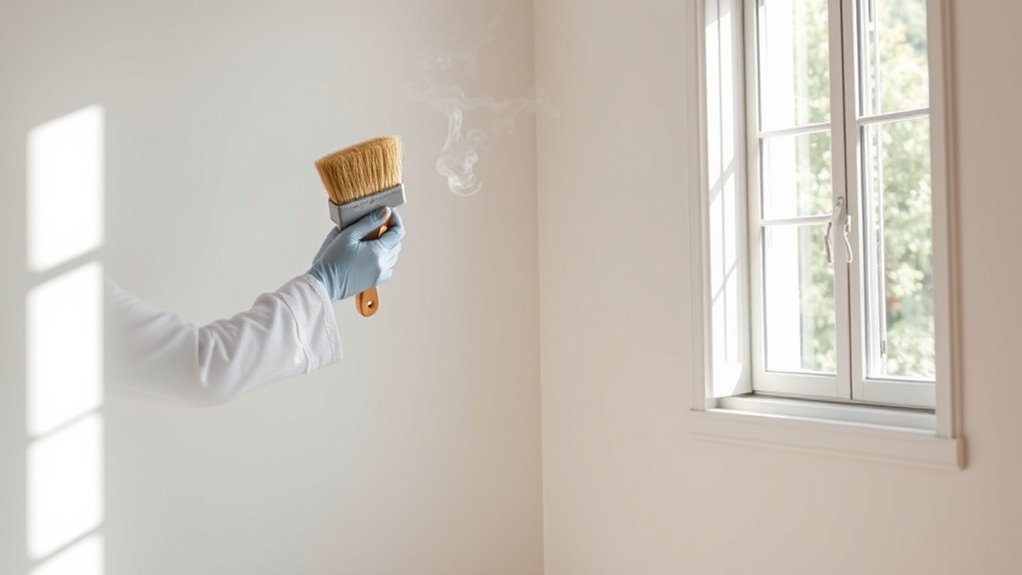
Creating a smoke-free environment is vital for protecting the health of everyone in your space. Implementing smoke-free policies not only shields employees and customers from secondhand smoke but also boosts morale and encourages smokers to quit. To maintain this environment, designate specific smoking areas away from flammable materials and high-traffic zones. Confirm these areas have clear signage and non-combustible receptacles for safe disposal. Regular monitoring and strict enforcement are essential for compliance. Additionally, educate everyone about the health risks associated with smoking and secondhand smoke exposure. Providing cessation resources and incentives can further promote a healthier workplace. Moreover, it is important to establish designated smoking areas to ensure safety and compliance on construction sites.
Frequently Asked Questions
How Long Does It Take to Completely Remove Smoke Odors?
When you’re dealing with smoke odors, the time it takes to remove them completely can vary widely.
Factors like the type of smoke, the materials involved, and how quickly you act play a big role. If you address it promptly, you might see improvements in days.
However, deep-seated odors, especially from cigarettes or fires, could take weeks or even months, often requiring professional help for thorough elimination.
Don’t wait too long; act quickly!
Can I Use Bleach to Clean Smoke Stains?
You might think bleach is a one-size-fits-all solution for cleaning, but it can be tricky.
While bleach effectively tackles mold, it mightn’t work well on smoke stains because of its corrosive nature.
If you decide to use bleach, always dilute it with water, and test it on a small area first.
Remember to wear gloves and guarantee good ventilation to avoid harmful fumes.
There are gentler alternatives that can work just as effectively!
Are There Specific Products Designed for Smoke Damage?
Yes, there are specific products designed for smoke damage. You can use dry-cleaning sponges to lift soot without spreading it.
Soot cleaners available at home improvement stores effectively remove stains, while trisodium phosphate (TSP) works well for tougher residues.
For odors, consider smoke damage removal products or ozone generators, which oxidize particles to eliminate smells.
Always guarantee proper ventilation and wear safety gear while working with these products for best results.
Will Cleaning Remove All Traces of Smoke Damage?
Cleaning can remove some traces of smoke damage, but it often won’t eliminate everything.
Surface stains might disappear with the right products, like mild detergents or vinegar. However, smoke particles can penetrate porous materials, making complete removal tricky.
You might still notice odors or deeper stains, especially with wet smoke. For extensive damage, you’ll likely need professional help to guarantee thorough cleaning and restoration of your space.
How Often Should I Clean Walls to Prevent Smoke Buildup?
Cleaning your walls is like brushing your teeth; it’s essential for maintaining freshness and preventing buildup.
To keep smoke and other grime at bay, you should clean your walls every three months, especially in high-traffic areas and kids’ rooms.
In kitchens and bathrooms, consider cleaning more often due to splatters and moisture.
Regular maintenance not only keeps your space looking good but also helps prevent tougher stains from forming over time.
Conclusion
In summary, tackling smoke stains and odors from your walls doesn’t have to be an intimidating task. With the right preparation and cleaning techniques, you can restore your space to its former glory. Remember, “an ounce of prevention is worth a pound of cure,” so take steps to maintain a smoke-free environment moving forward. By staying vigilant and proactive, you’ll not only enhance your home’s appearance but also create a healthier atmosphere for everyone.
